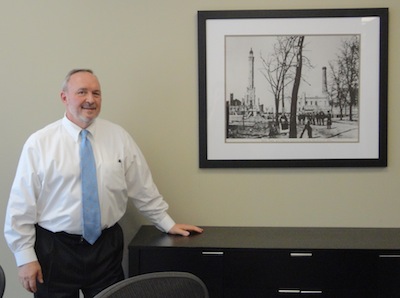File this one under “People unclear on the concept.” On September 29, the Chicago Department of Transportation announced it had launched the bidding process for the $32.5 million Central Loop BRT project and released final plans for the corridor. Yesterday, the Building Owners and Managers Association of Chicago published an ill-informed op-ed piece in Crain’s, warning that the current design for Washington Street will create carmaggedon, including crashes caused by right-turning vehicles.
It’s odd that the article, written by BOMA vice president Michael Cornicelli, contains so many misconceptions about the plan. The city met with the association several times to discuss the project, according to CDOT spokesman Pete Scales.
“It's difficult to imagine Chicago's downtown traffic becoming worse, but that could be the result if the city of Chicago doesn't steer its Central Loop Bus Rapid Transit plan in the right direction,” Cornicelli warns. He claims that the BRT project will reduce the number of lanes available to motorists on Washington from the current four or five to only two, in order to make room for the dedicated bus lanes, island bus stations, and a protected bike lane. “Reducing vehicular capacity by half on this heavily traveled route means a dramatic increase in congestion and delays.”
Actually, in addition to maintaining two through lanes for motorists at all times, the design provides left- and right-turn lanes where these turns are permitted, which means three or four lanes will be available to motorists. True, car traffic will move somewhat slower on eastbound Washington and westbound Madison after BRT is implemented on these streets, but there are plenty of parallel streets that can be used as alternatives.
Meanwhile, CDOT predicts the project will make an eastbound trip across the Loop 25 percent shorter, and a westbound trip 15 percent shorter. While cars and taxis occupy most of the downtown street space and cause most of the congestion, buses make up only four percent of motor vehicles in the Loop but move 47 percent of the people traveling in vehicles. BRT will speed commutes for an estimated 30,000 people per day, which more than justifies slightly longer travel times for a much smaller number of drivers.
Cornicelli also frets that, after the street remix, delivery trucks parking in one or both of the remaining through lanes will bring car traffic to a standstill. “If curbside deliveries were made simultaneously on both sides of the street, vehicular traffic would be obstructed completely,” he warns.
It’s doubtful that two truck drivers would be dumb enough to create that kind of doomsday scenario. Rather, deliveries will be made via north-south streets or Calhoun Place, the alley that runs just south of Washington for most of the width of the Loop. Police enforcement will help keep drivers out of the bus and bike lanes; officers will also ticket delivery drivers who block the through lanes, so truckers will quickly learn they can’t make curbside deliveries on Washington.
Cornicelli really demonstrates his lack of research into the BRT project when he argues that it will result in crashes from drivers turning right across the bus and bike lanes. “Cyclists in the curbside lane will be hidden by the buses from view, creating serious risk of collisions when cyclists disregard traffic signals,” he argues. “Anyone who has traveled in downtown Chicago has witnessed firsthand how frequently traffic laws are ignored by large numbers of cyclists.”
Actually, as a recent CBS report found, traffic laws are frequently ignored by Loop motorists and pedestrians, as well as cyclists. Right turns by motorists from Washington onto LaSalle will be prohibited. At other intersections, drivers will be permitted to merge across the bus lane and into right turn bays.
To avoid conflicts between right-turning motorists and cyclists, each mode will get a dedicated signal phase, similar to how turns currently work on the Dearborn protected lanes. On Dearborn, red-light compliance by bike riders improved by 161 percent after CDOT installed dedicated bike stoplights, so it’s highly unlikely the bloodbath Cornicelli is predicting will materialize.
I’m not sure why BOMA waited more than six weeks after negotiations with CDOT were finished to voice these concerns. Utility work on Washington to prepare for the project has been underway for more than two months. At any rate, Cornicelli’s apprehensions are based on a misunderstanding of the project. Next time, he should follow the Bob Dylan rule: “Don’t criticize what you don’t understand.”






